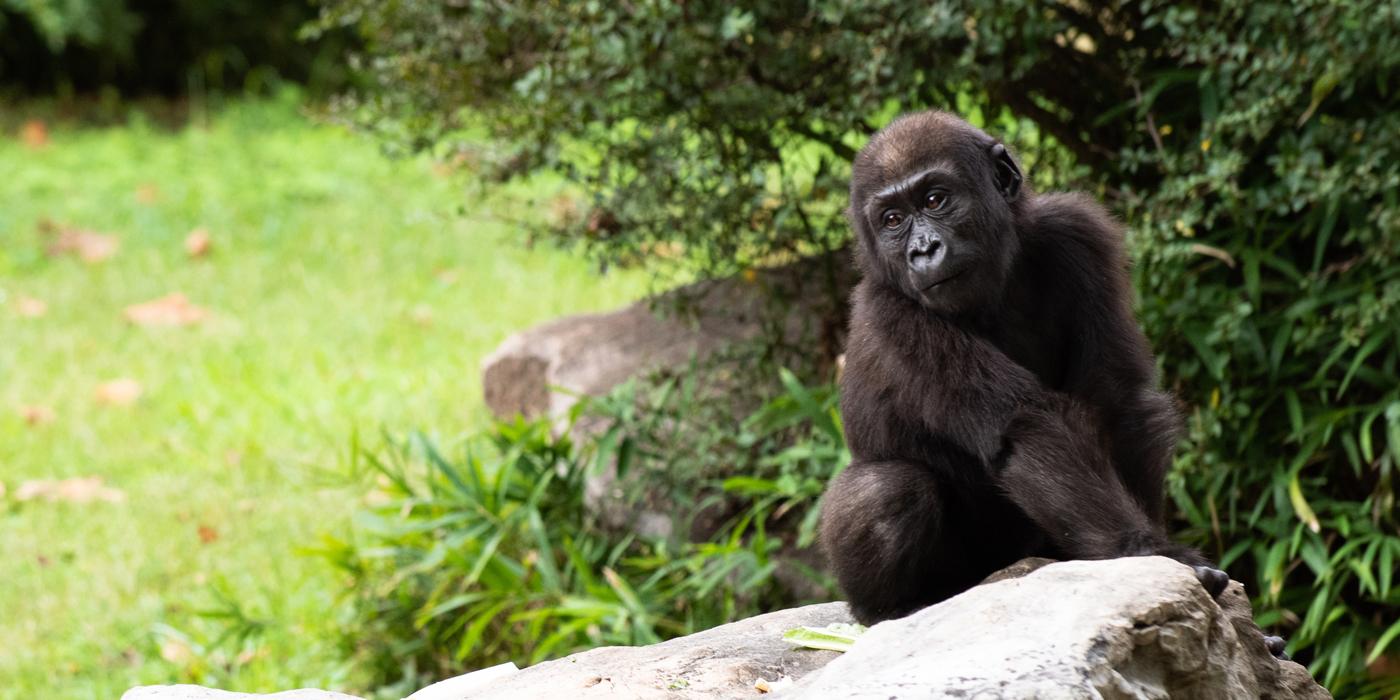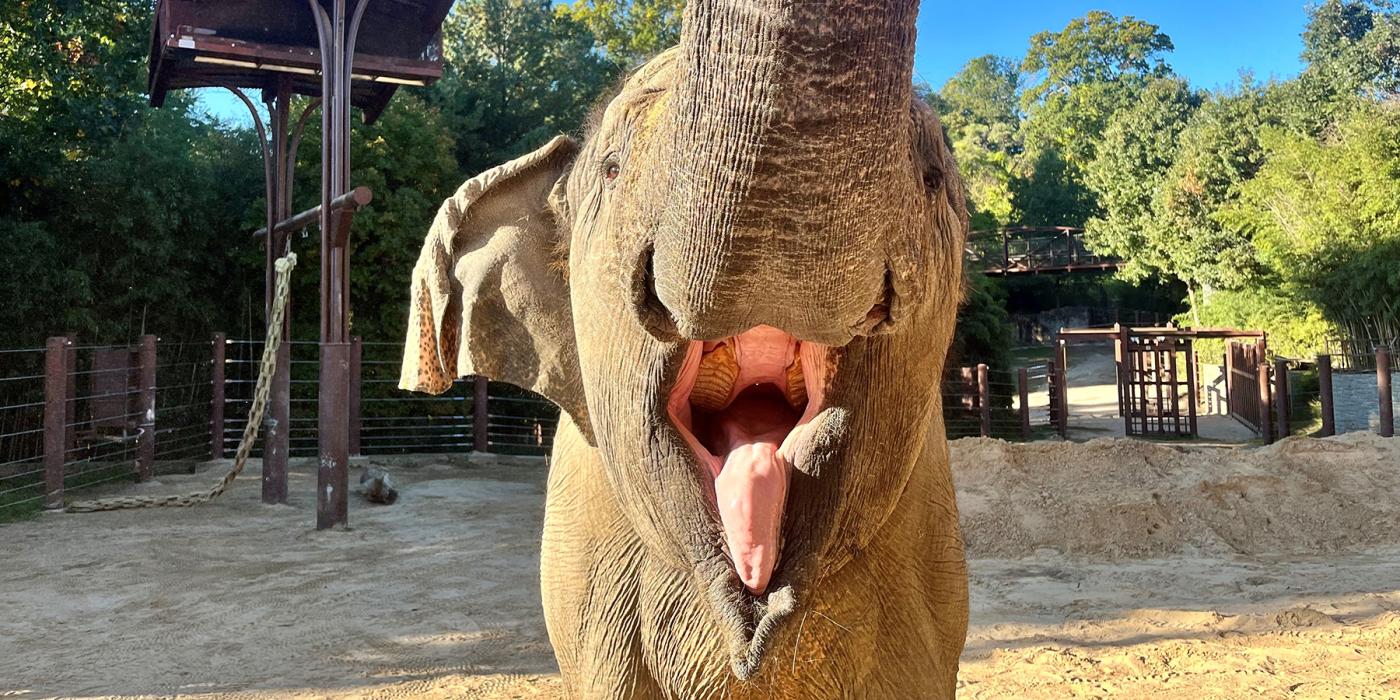Bringing the Zoo to You: April 2020 Edition
Chirping cheetah cubs, a birthday party fit for a gorilla and a Madagascar hedgehog tenrec indulging in some self-care with a dust bath—all of these events (and more) made for an eventful month at the Smithsonian’s National Zoo and Conservation Biology Institute. We’ve gathered some of our favorite animal antics from April, courtesy of the keepers who are working diligently behind the scenes to ensure every one of our residents receives the best care.
Western Lowland Gorilla | Great Ape House
On April 15, our confident little western lowland gorilla, Moke, marked yet another big milestone—his 2nd birthday! Keeper Alex Reddy reflected on Moke's growing independence, bold personality and training triumphs in the latest #GorillaStory update.
Although visitors couldn’t be at the Zoo to celebrate his big day, primate keepers shared the love...and a sneak peek of his party! The talented team in our Department of Nutrition Sciences provided the pièce de résistance: a cake made from apple, grape and pineapple juices. Hidden inside are slices of grapefruit and lemon, and the cake is topped with blueberries, cranberries, white grapes and strawberries. The light green "frosting" is made from sweet potato paste, and Moke's name was crafted out of leaf-eater biscuit paste. Keepers serenaded the birthday boy with a rousing chorus of 'happy birthday to you!'
Cheetah | Smithsonian Conservation Biology Institute
It’s a girl—and three boys! At the Smithsonian Conservation Biology Institute, first-time mother Echo gave birth to four chirping, squiggly cubs April 8 live on the Cheetah Cub Cam. An important part of cub care and management is weighing the cubs, which helps the carnivore team know they are growing and thriving. Keepers shave a tiny bit of fur on each cub so that they can tell them apart. This ensures that they know which cubs weighs what amount and lets them track their growth.
At this week’s weigh-in, the cubs tipped the scales! The largest cub (nicknamed “base of tail” for his shave mark) weighed 1.63 kg, or 3.5 pounds. His brother “left shoulder” weighed 1.58 kg, or 3.4 pounds. The female “right hip” weighed 1.53 kg, or 3.3 pounds. Last but not least, the smallest cub—a male nicknamed ”left shoulder”—weighed 1.52 kg, or 3.3 pounds.
Madagascar Hedgehog Tenrec | Small Mammal House
Even for Madagascar hedgehog tenrecs, self care is so important. This little fellow is taking a dust bath and scent-anointing (rubbing the new scent into his spines). Keepers give our tenrecs novel scents and substrates as enrichment to encourage this natural behavior. In the wild, scent can be used as camouflage and parasite repellent!
Lemurs | Lemur Island
Happy birthday to Bowie, Tom Petty, Southside Johnny, Birch, Aloke and Wiley! To mark our ring-tailed and black-and-white-ruffed lemurs’ birthdays, keepers in the Zoo’s Department of Nutrition Sciences whipped up a truly colorful cake. The layers are made from the boys’ favorite foods, including frozen apple and cranberry juices, strawberries, grapes, kiwi, applesauce, corn, peas and kale. The “icing” is made from powdered sweet potato and topped with some fresh raspberries for decoration. Bon Appétit!
Red River Hog| Cheetah Conservation Station
Let’s bob for snacks with Bobbie, our red river hog! To root around for pieces of produce in her water tub, Bobbie blows bubbles and uses her sense of touch and smell to locate broccoli, turnips, sweet potatoes, grapes and blueberries. Enrichment activities like this replicate the hogs’ foraging around rivers and streams in western central Africa. Cheetah Conservation Station keepers say Bobbie is always eager to “bob” for snacks, while her sister Tangerine prefers to dump the bucket and pick them up instead.
Stanley Crane | Bird House
Stanley crane Alice is unlike any other bird of her species. Hand-raised by keepers, she has a sweet temperament and joyous personality. When she sustained a leg injury last summer, animal care staff rallied around Alice and found an innovative solution to help her thrive. Keeper Debi Talbott shares the remarkable story of Alice's road to recovery. Read her update.
Hereford Cow and Miniature Donkey | Kids’ Farm
The Kids' Farm crew is ready to zoom! Jolly balls and brush barrels are some of Hereford cow Willow's favorite enrichment toys to chase and knock about. These items encourage her to keep physically fit and mentally sharp. Donkeys Pat, Flash, George and Giuseppe seem to use them as an obstacle course.
White-Naped Crane | Smithsonian Conservation Biology Institute
White-naped cranes Brenda and Eddie are parents again! Their fourth chick, a female, hatched April 2 at the Smithsonian Conservation Biology Institute. This chick is the 46th white-naped crane to hatch at SCBI. Prior to hatching, scientists confirmed the chick’s sex using DNA samples taken from inside of the egg. Keepers report Brenda and Eddie are providing excellent care to their chick.
Bird keepers have had great success producing chicks from cranes that have behavioral or physical impediments that prevent them from breeding. The chick’s parents are one of the only white-naped crane pairs living at the research facility capable of breeding naturally. There are an estimated 5,000 white-naped cranes living in the wild, and the species is listed as vulnerable by the International Union for Conservation of Nature.
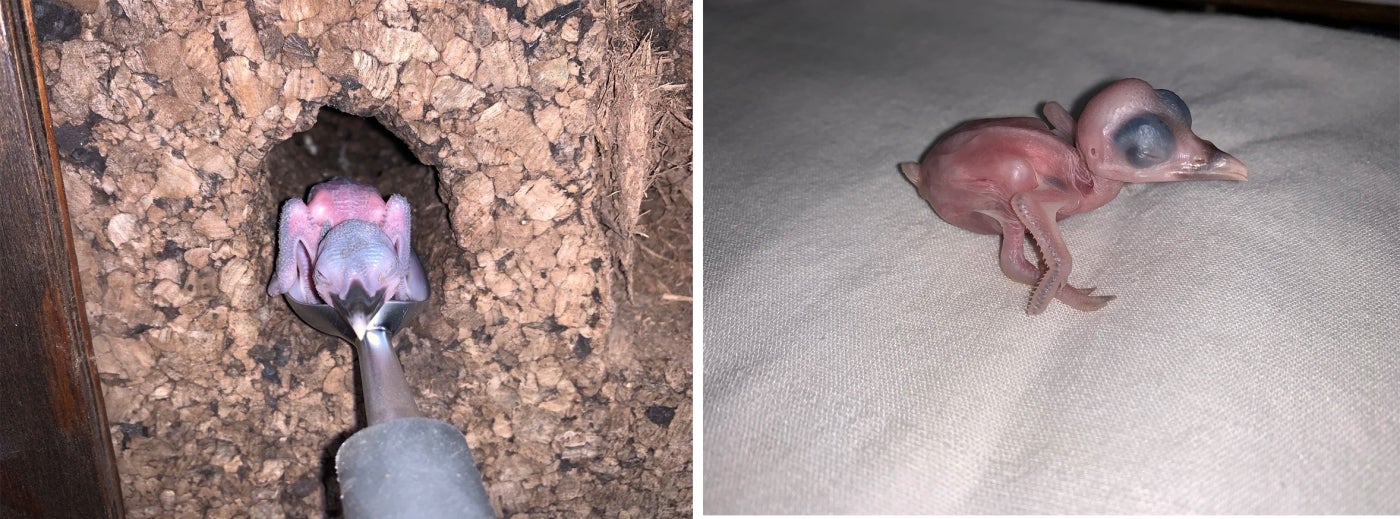
Guam Kingfisher | Smithsonian Conservation Biology Institute
Guam kingfishers are small, sassy and the most endangered animals in the Smithsonian Conservation Biology Institute’s collection. With only approximately 135 Guam kingfishers remaining in the entire world, every chick is precious. SCBI’s bird team recently celebrated the arrival of two chirping chicks, which hatched April 21 and 23. They are the first offspring for 11-month-old father Animu (ah-KNEE-moo) and 2-year-old mother Giha (GEE-ha). To assist the new parents, keepers are allowing them to raise the older chick, a female, while animal care staff hand-rear the younger, a male. These two healthy, thriving chicks bring the total number of kingfishers under SCBI’s care to eight. Learn more in keeper Erica Royer’s update!
Clouded Leopard | Asia Trail
Going out on a limb here, but we think Paitoon and Jilian are two of the cutest clouded leopards around! In celebration of their first birthdays, Asia Trail keepers Jenny Spotten and Kaleigh Shaw give a sneak peek into a very important aspect of caring for these cubs: training! Read the update.
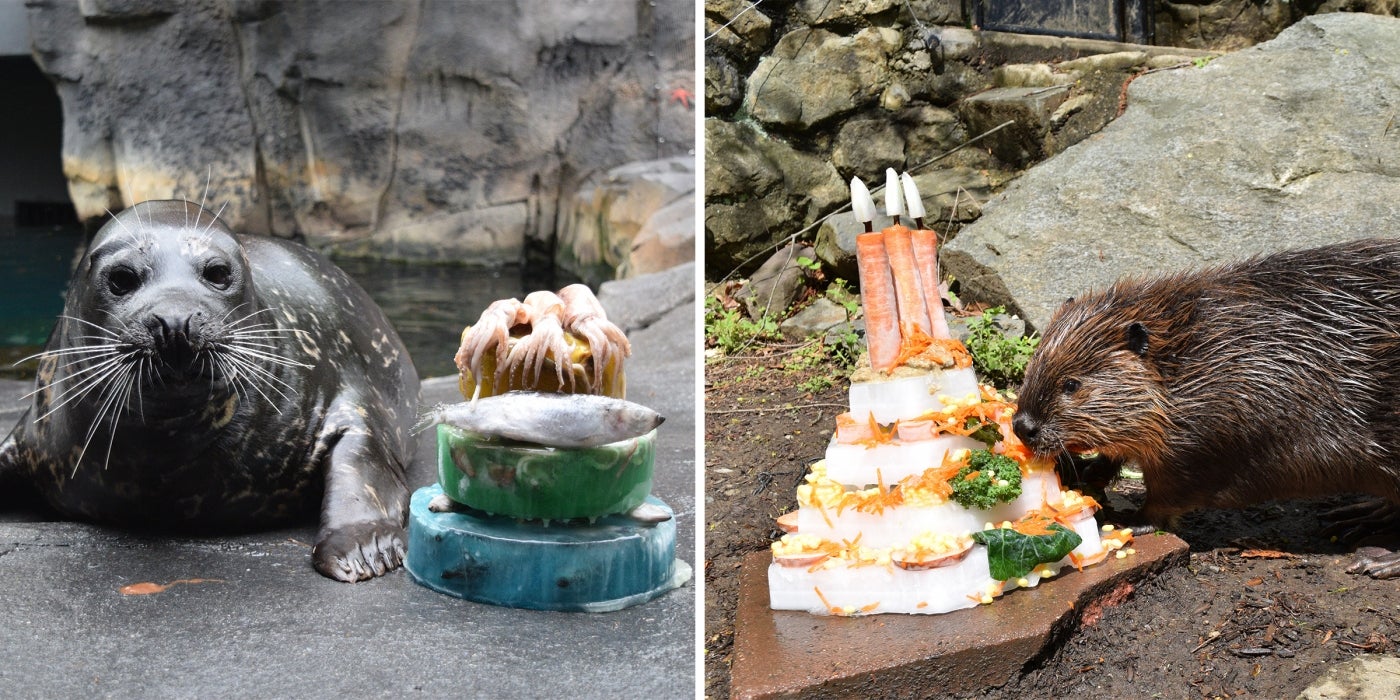
Harbor Seal and North American Beaver | American Trail
Keepers at the American Trail habitat celebrated two birthdays this month. Harbor seal Rabbit turned a very lucky 13 April 13, and North American beaver Aspen turned 3 April 14. The Zoo’s Department of Nutrition Sciences crafted some special species-appropriate ice “cakes” for the birthdays boys. While Aspen’s cake was topped with some clever carrot “candles,” Rabbit’s was decked out with some squid to snack on.
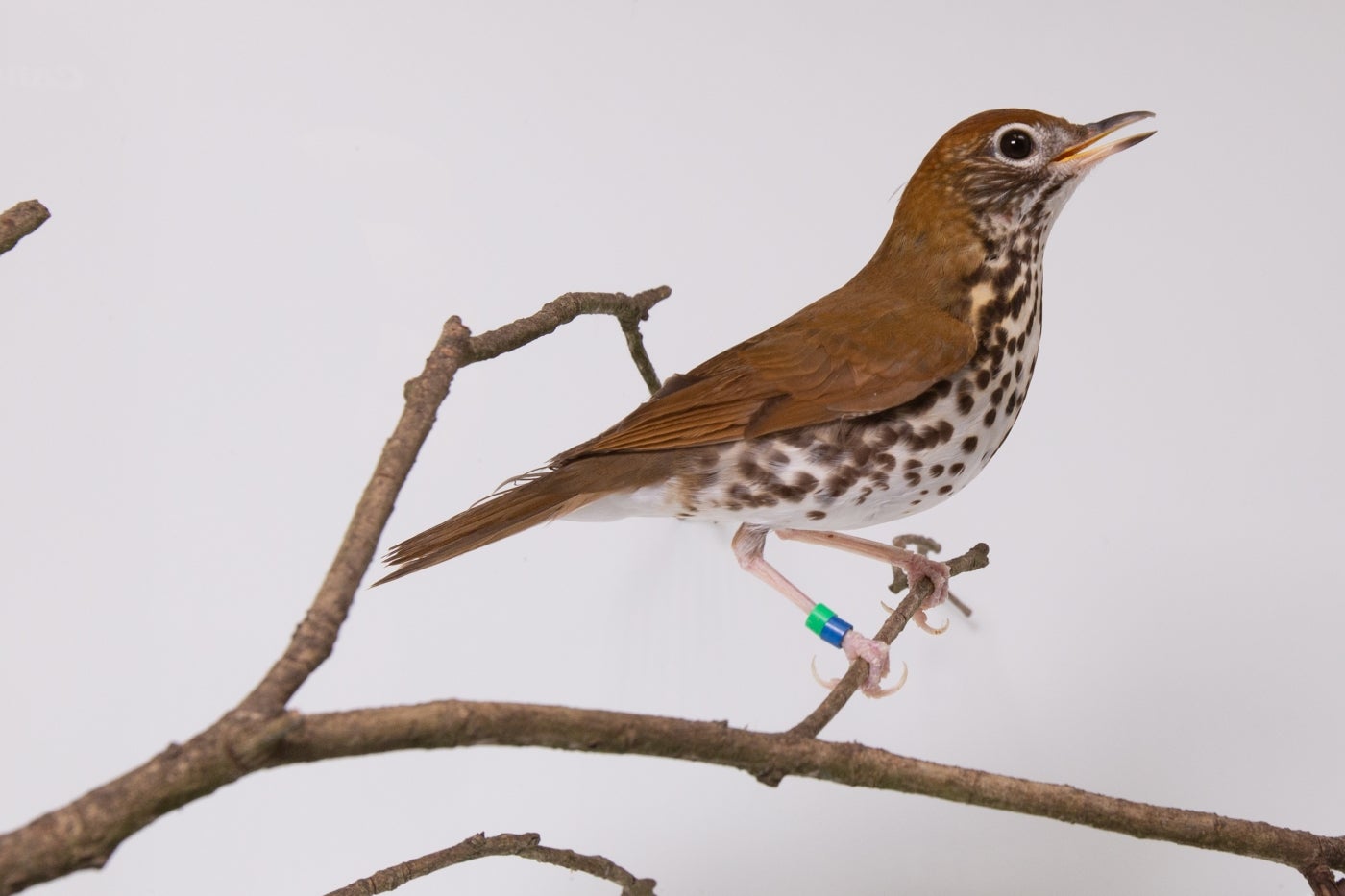
2019 Plume Award Winner | Bird House
The Smithsonian’s National Zoo’s historic Bird House may be under renovation, but that has not stopped the animal care team from bringing native shorebirds, songbirds and waterfowl under their wing to establish best practices in husbandry and breeding. Last year, keepers celebrated many significant hatchings behind the scenes—including flamingos, wood thrush, scarlet tanagers, indigo buntings and a band-tailed pigeon.
For their efforts to propagate these species, the Bird House team recently received the prestigious Plume Award for “Achievement in Avian Husbandry.” This honor was bestowed by the Association of Zoos and Aquariums’ Scientific Advisory Group in recognition of the team’s expertise and skills to aid in the recovery of threatened and endangered Western Hemisphere migratory bird populations.
As threats to migratory birds in North America intensify and bird populations decline, there is a growing interest among zoos in the conservation and management of native songbirds. Bird House keepers are developing the husbandry and reproductive programs for North American migratory songbirds. By working to understand their needs, the Zoo stands ready to offer assistance to populations in decline as well as contribute to the understanding of common birds. Cracking the code of breeding these species in human care while they are still common is vital for future conservation efforts.
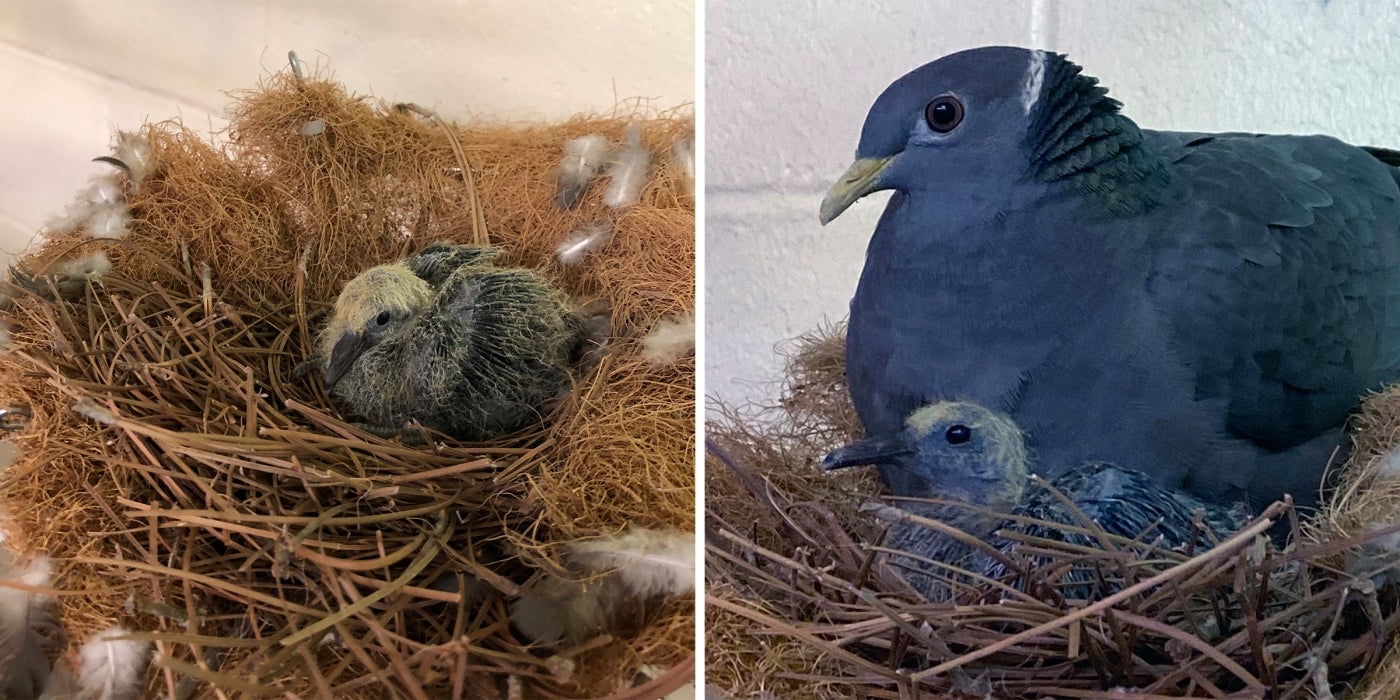
Band-Tailed Pigeon | Bird House
Peep, peep, hooray! Our Bird House team recently welcomed a band-tailed pigeon chick, or “squab,” April 14. This is the second squab for its 3-year-old mother and 2-year-old father. Their first squab, a male named Flash, hatched in July 2019. Keeper Shelby Burns shares the secret of their success.
“Band-tailed pigeons are beautiful birds with a lot of personality! To set the mood for breeding, we built the pigeons’ exhibit with their natural habitat in mind. This entailed offering them plenty of places to perch, vegetation to hide in and UVB lights to bask under. We also gave them several nesting location options and materials, including coconut fibers and pine needles. This pair learned from their last successful hatching and created an even sturdier, more intricate nest by adding pine needles and molted feathers.
“Mom laid an egg March 27, and both she and dad took turns incubating it. Dad took the morning shift, and mom relieved him of his duty in the afternoon and evening. Band-tailed pigeons typically incubate for 16 to 22 days. This squab hatched right on time: day 18. This pair has continued to learn and improve their parenting skills. Both mom and dad are very attentive to the squab and take turns feeding it crop milk. In less than a month, it will fledge from the nest. We are excited that this family continues to grow, and we look forward to guests meeting them in our Bird Friendly Coffee farm aviary when the Bird House opens in fall 2021!”
Asian Elephant | Elephant Trails
Have dinner with Bozie! How much does a female elephant eat? Bozie’s ‘Zoo Menu’ includes 2.5 bales of hay, alfalfa pellets fortified with nutrients, bran, oats, fruits, veggies, apple fiber biscuits and browse (thin, leafy branches). Altogether, that’s about 135 lbs. of food a day per elephant!
Keepers feed the Zoo’s elephants throughout the day to simulate their natural foraging behavior. Specially designed nooks and puzzle feeders located through the habitat challenge the elephants to think and problem solve to retrieve the food inside. Elephants are able to learn quickly, so keepers continually alter and enhance enrichment objects to keep the experience fresh, fun, and interesting for the animals.
This story appears in the May 2020 issue of National Zoo News.